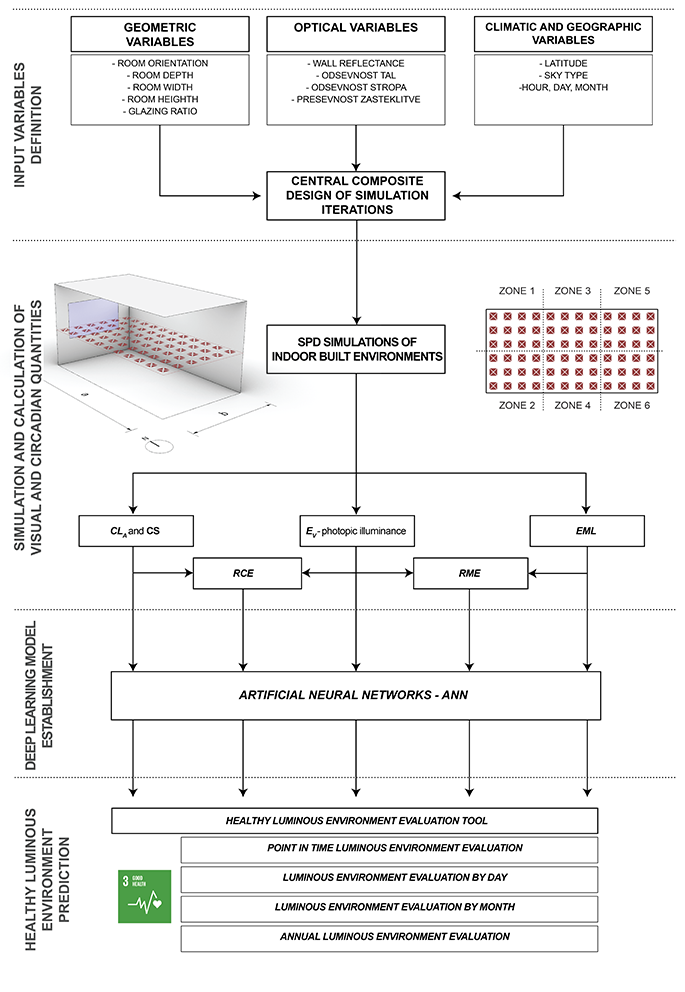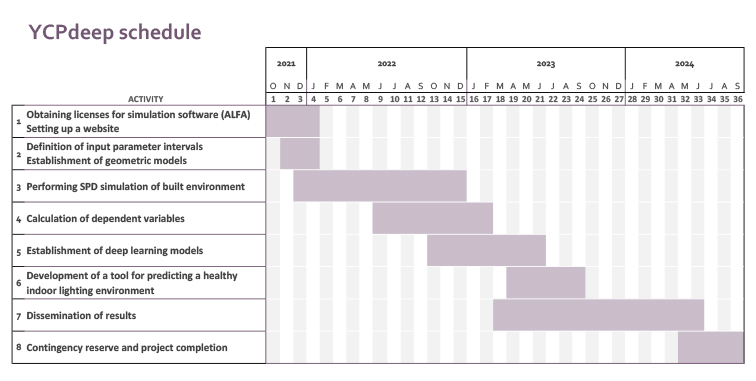PROJECT YCPdeep
Calculation of Yearly Circadian Potential in Buildings Using Deep Learning Techniques
/
PROJECT DESCRIPTION:
Recent discoveries in the field suggest that daylight is the most important daily circadian rhythm synchroniser in humans. The third photoreceptor type ipRGCs (intrinsically photosensitive Retinal Ganglion Cells) affect the secretion of melatonin – a sleep hormone that regulates the wake-sleep cycle. The response of the circadian phototransduction system is very different from the visual one, as it is maximally sensitive to light in the blue part of the spectrum and is time-conditioned. Light is desirable in the morning, but in the evening, it is recommended to avoid high light levels rich in blue light. Due to the complexity of estimating the circadian light content, this cannot be achieved with conventional visual daylighting simulation tools. Currently, tools capable of calculating the received spectral composition of radiation, which allow the evaluation of light from the circadian system’s point of view, are limited to the point-in-time spectral content evaluation.

The main goal of the YCPdeep project is to create a tool for predicting the “health” potential of the indoor lighting environment that will reliably predict the circadian and visual part of the indoor daylighting environment in buildings from the user’s point of view. This will be enabled for a selected point-in-time, day, month, or whole year for locations between 35º to 60º northern geographic latitude. The tool will function on the basis of an neural networks model and will be able to reliably predict circadian light using basic data about geometric and optical properties of the considered space as well as climatic data of the location. The proposed variation of the parameters will ensure the general applicability of the devised tool. The results of each of the iterations of multispectral simulations will be assessed using state-of-the-art methods for evaluating the circadian light content. The artificial neural networks model, which will be created on the basis of the mentioned simulation database, will be able to predict visual and circadian daylighting for any selected time of a year. Such a model will then be implemented in an online tool for evaluation of a healthy daylighting environment, which in addition to light quantities at a certain point-in-time will also allow estimation of the average amounts of circadian and visual light, while evaluating the duration of exposure to circadian and/or visually appropriate daylight for a period of a day, month or whole year using the newly proposed metrics of climate-based circadian light. The proposed tool will be the first of its kind in the field of daylighting and will enable the user to easily and quickly obtain the mentioned results on the basis of geometric, optical, and climatic input data.
PROJECT SCHEDULE:

/
RESEARCH TEAM:
/
PUBLICATIONS:
Original article:
ŠPRAH, Nataša, POTOČNIK, Jaka, KOŠIR, Mitja. The influence of façade colour, glazing area and geometric configuration of urban canyon on the spectral characteristics of daylight. Building and Environment. [Online ed.]. March 2024, vol. 251, [atricle no.] 111214, 17 str., ilustr. ISSN 1873-684X. Digitalna knjižnica Univerze v Mariboru – DKUM, Repozitorij Univerze v Ljubljani – RUL, DOI: 10.1016/j.buildenv.2024.111214.
POTOČNIK, Jaka, PAJEK, Luka, KOŠIR, Mitja. Experimental investigation of the impact of model complexity on indoor daylight spectral simulations. Developments in the built environment. dec. 2024, art. 100543, vol. 20, str. 1-15, ilustr. ISSN 2666-1659. DOI: 10.1016/j.dibe.2024.100543.
POTOČNIK, Jaka, KOŠIR, Mitja. The necessity for multi-spectral simulations of the indoor non-visual luminous environment – a simplified annual approach. Buildings. [Online ed.]. maj 2023, št. 5, art. 1357, letn. 13, str. 1-31, ilustr. ISSN 2075-5309. https://www.mdpi.com/2075-5309/13/5/1357, https://repozitorij.uni-lj.si/admin/GradivoOsnovno.php?id=146417, Repozitorij Univerze v Ljubljani – RUL, DOI: 10.3390/buildings13051357.
Conference papers:
POTOČNIK, Jaka, KOŠIR, Mitja. Deep learning techniques for prediction of nonvisual luminous content of cellular offices. V: EuroSun2024 : ISES and IEA SHC International Conference on Sustainable and Solar Energy for Buildings and Industry : 23. – 30. August 2024, Limassol, Cyprus : proceedings. Freiburg: International Solar Energy Society, cop. 2025. Str. 98-109, ilustr. ISBN 978-3-9826306-0-1. https://proceedings.ises.org/conference/eurosun2024/EuroSun2024-Proceedings.pdf, DOI: 10.18086/eurosun.2024.01.10.
KOŠIR, Mitja, POTOČNIK, Jaka, ŠPRAH, Nataša. Influence of sky view factor and façade color on spectral daylight properties at the façade in urban canyon. V: BERARDI, Umberto (ur.). Multiphysics and multiscale building physics : proceedings of the 9th International Building Physics Conference (IBPC 2024). Vol. 4, Indoor air quality (IAQ), lighting and acoustics. Singapore: Springer, cop. 2025. Str. 273–278, ilustr. Lecture notes in civil engineering, vol. 555. ISBN 978-981-97-8317-5. ISSN 2366-2565. https://link.springer.com/chapter/10.1007/978-981-97-8317-5_40, DOI: 10.1007/978-981-97-8317-5_40.
POTOČNIK, Jaka, PAJEK, Luka, KOŠIR, Mitja. Importance of Model Level of Detail and Level of Information in Non-image Forming Simulations: A Case Study on Real-life Office. V: Proceedings of the Solar World Congress 2023 in New Delhi, India : Solar world congress 30 oct – 04 nov 2023, Nev Delhi, India. Freiburg: International Solar Energy Society, 2024. Str. 486-493, ilustr. ISBN 978-3-9820408-9-9. https://proceedings.ises.org/citation?doi=swc.2023.06.08&mode=list, DOI: 10.18086/swc.2023.06.08.
POTOČNIK, Jaka, KOŠIR, Mitja. Predicting the melanopic potential of indoor coloured surfaces using artificial neural networks. V: RAKOČEVIĆ, Marina (ur.), ŠĆEPANOVIĆ, Biljana (ur.). GNP 2022 Proceedings : The Eighth International Conference Civil Engineering – Science & Practice, Kolašin, 8-12 March 2022. [Podgorica]: University of Montenegro Faculty of Civil Engineering, 2022. Str. 691-688, ilustr. ISBN 978-86-82707-35-6.
Software:
KOŠIR, Mitja, POTOČNIK, Jaka. YCPdeep tool – Yearly Circadian Potential Calculation Tool : verzija. Ljubljana: UL FGG, KSKE, 2024. https://kske.fgg.uni-lj.si/en/project-ycpdeep/, http://ycpdeep.com/.
/
FINANCING INFORMATION AND LOGOS OF THE MAIN FINANCERS:
The project is funded by the Slovenian Research Agency (ARRS) under the call “Public call for the (co-) financing of research projects in 2021”
Type of the research project: Small Basic Project – 100 000 EUR/year
Project title: Calculation of Yearly Circadian Potential in Buildings Using Deep Learning Techniques
Acronym: YCPdeep
Project No.: J2-3036
Project duration: 3 years, 1. 10. 2021 – 30. 9. 2024
